It’s that time of year again — hummingbirds are already flying toward their winter destinations. If you live anywhere south, it’s the perfect time to make sure your gardens are extra welcoming to the little zoomers. I’m seeing lots of Ruby-Throats right now, males and females both.
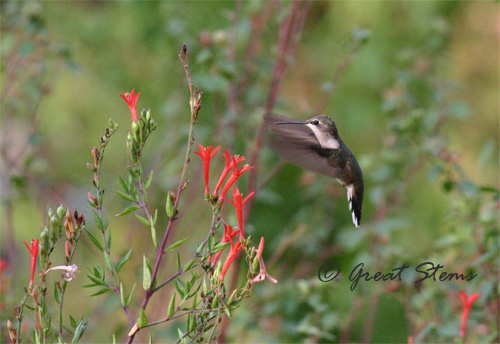 Hummingbirds love both nectar plants and feeders in the garden. If you can provide both, you’ve got a great chance to attract the little cuties. I always say that you should get your native plants in the ground right away but use feeders to help the hummingbirds find your garden faster.
Hummingbirds love both nectar plants and feeders in the garden. If you can provide both, you’ve got a great chance to attract the little cuties. I always say that you should get your native plants in the ground right away but use feeders to help the hummingbirds find your garden faster.
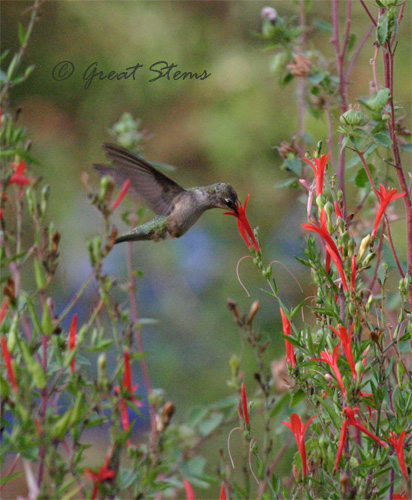 Hummingbirds are very much attracted to tubular flowers in the red and orange color range, but some visit a variety of nectar plants. Some of the hummingbird favorites I plant in my garden include:
Hummingbirds are very much attracted to tubular flowers in the red and orange color range, but some visit a variety of nectar plants. Some of the hummingbird favorites I plant in my garden include:
* Signifies native to Texas
-
Flame Acanthus (shown) *
-
Turk’s Cap *
-
Firebush
-
Cigar Plant
-
Standing Cypress *
-
Autumn Sage *
-
Tropical Sage *
-
Other Salvias
-
Crossvine *
-
Coral Honeysuckle *
-
Red Yucca *
-
Lantana, Texas *
-
Zinnias
-
Purple Coneflower *
-
Butterfly Bush
-
Yellow Bells *
-
Texas Betony *
-
Red Columbine *
Hummingbirds also eat insects and small spiders for their protein, so it is important to avoid using pesticides in your hummingbird garden. Mosquitoes, gnats, aphids, fruit flies, midges, and more provide important nutrients in the hummer diet — what wonderful garden helpers hummingbirds are!
Birdbaths
Hummingbirds love shallow running water. I have a variety of water features at my house for birds in general, but today I decided that it is my new goal to put in a special birdbath created especially with hummingbirds in mind. I’ll put it in the backyard garden they frequent the most. I want to get a picture of a hummer taking a bird bath in a birdbath!
Feeders
When choosing a feeder, the top priorities are:
- Is it easy to clean, including the inside of the basin? See below for more info on cleaning.
- Does it have an all red basin? See the info about bees below.
- Is it made of a safe material? (in other words, no metal)
My favorite hummingbird feeder is the Hummzinger — it has a little perch for the hummers and it is oh so easy to clean. A built-in ant moat keeps ants from reaching the feeder.
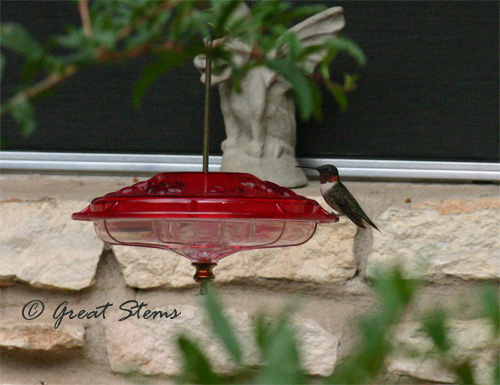 The company also makes a window version — my parents love using one on their camper. We keep ours on the kitchen window. It uses little suction cups, and it lets you watch the little flyers up close.
The company also makes a window version — my parents love using one on their camper. We keep ours on the kitchen window. It uses little suction cups, and it lets you watch the little flyers up close.
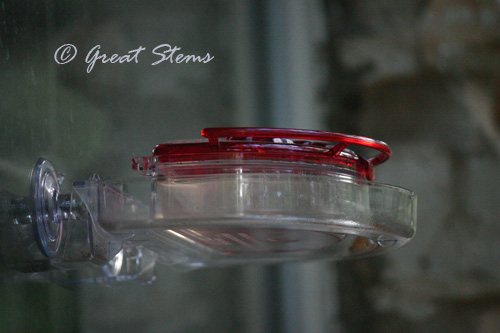 Feeders don’t have to be gorgeous. You really want them to be functional, and that means easy to clean and red in color. Pretty simple really.
Feeders don’t have to be gorgeous. You really want them to be functional, and that means easy to clean and red in color. Pretty simple really.
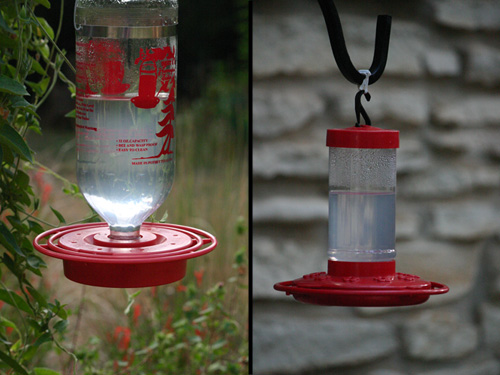 And no metal parts — iron from rust and iron that leeches from metal can kill hummingbirds in a short amount of time.
And no metal parts — iron from rust and iron that leeches from metal can kill hummingbirds in a short amount of time.
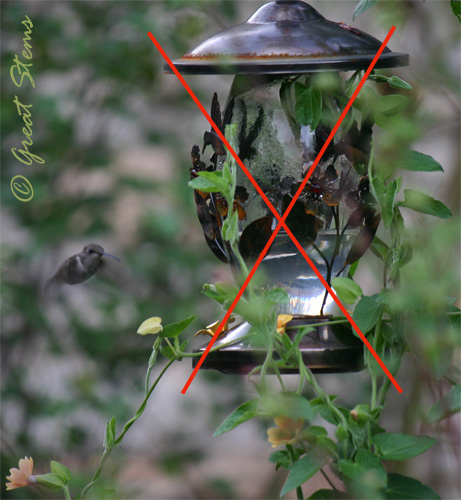 Filling the Feeder
Filling the Feeder
The following recipe has become the standard for safe hummingbird nectar:
Nectar Water Recipe
4 parts water to 1 part white cane sugar
- Never use food coloring or another additive, and do not use turbinado, raw sugar, honey, or brown sugar — these can be dangerous or even deadly.
- It is not necessary to boil the water first.
- It is okay to change this recipe to 5 parts water in the hot summer and 3 parts water in the cold winter, but if in doubt, stick to 4:1 recipe.
- You don’t need to fill the feeder to full each time — put in an amount that is likely to be used in that short time period.
Bees, Wasps, and Ants
Bees and wasps are attracted to the color yellow, so they are drawn to feeders that have little yellow flower parts. If you are having trouble with bees or wasps and your feeder has yellow flowers, either remove the yellow part or replace your feeder with one that has an all-red basin.
Ants can be avoided by using a feeder with a built-in ant moat or by purchasing an ant moat that hangs above the feeder. Use plain water in the moat and never add anything to it, since small birds sometimes like to drink water from the moat.
Cleaning Your Feeder
Be sure to clean your feeder every 3 days and replace the sugar water. This prevents the growth of black mold and the spread of disease between hummingbirds.
To clean, open the feeder up and use a bottle brush to scrub out the inside. Be sure to get all the potential hidden spots that some feeders seem to have — if you can’t clean it, I promise you that mold will start to grow there. If using a mild dishwashing detergent, make sure that rinse the feeder very thoroughly. And every few weeks, use vinegar to give a good cleaning.
To scrub the tiny holes, use a small brush as shown below. These are very inexpensive and available online or at many stores that sell feeders.
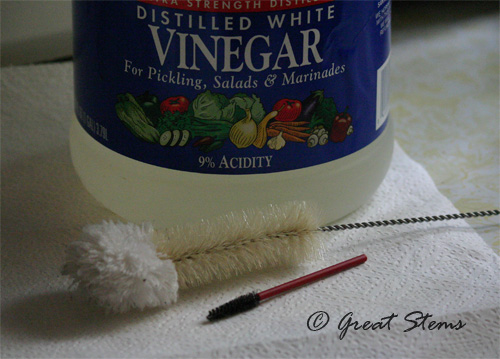
Enjoy Your Hummingbird Visitors
When the hummingbirds arrive, be prepared for some feisty behaviour. They don’t like to share with each other much, so you’ll get to hear them fuss at each other as they try to keep other hummers from using the feeders or plants. I’m sure they are quite serious in their endeavours, but to humans it seems pretty cute.
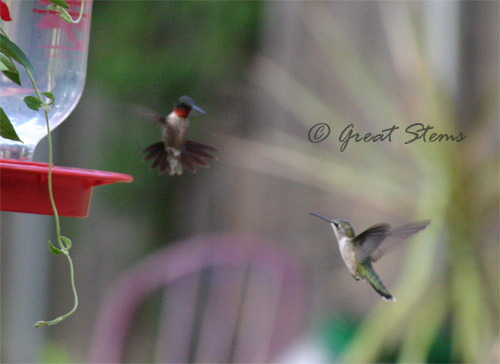 Here in the South, I keep my feeders up year-round. There is always the chance that a straggler hummer will be in need of an energy source, and if plants are not blooming, I want to provide for them.
Here in the South, I keep my feeders up year-round. There is always the chance that a straggler hummer will be in need of an energy source, and if plants are not blooming, I want to provide for them.
Welcome, little birdies, to our hummingbird haven. And good luck with the hummers in your own haven!
I love to see how the bird bends its body, balances with wings while sucking nectar… such aerial skill. They are delicate birds too judging by your explanation…. ~bancghik
The nice thing about photographs is that we can capture their movements and learn so much more about them. They move too fast for our human eyes to see otherwise!
I’ve seen a couple of hummingbirds in my yard this week, one in the flame acanthus out front and one in the firespike out back. I didn’t even think about it being migration time. What a great haven you’ve got for these guys, and your pictures are amazing as always!
Great Hummingbird photos and lovely garden! I started making my own sugar water for Hummingbirds, I love them! The birds sure get territorial with the feeder. Thanks for the cleaning feeder tips. Have a wonderful weekend!
Meredith
We don’t have little hummers here in Scotland so its such a pleasure to view beautiful pictures like yours and read about their likes and dislikes. Those pictures are just amazing.
good to know – I very very rarely see hummingbirds. I’d love to have some around.
Meredith I’ve read that the 3:1 ratio actually comes out to be about 23 percent sugar and the 4:1 comes out to be 18 percent, so I don’t think it’s that bad if you use the 3:1 in the summer. The average concentration in hummer plants is about 20-25%
I just make sure mine doesn’t spoil and I keep it under the shade. I think either ratio would work though, since in nature the concentration very from 17 percent up to 50 percent like in the bee balm.
I’ve heard that they might drink less from 1/3 but I haven’t really noticed much difference personally.
My hummers are going crazy on the plants and on the feeder that I keep on the patio. I’ve also planted turks cap along the patio for another close-up view. But I sure can’t nab the pictures you have! I’m very impressed. And thanks for a wonderful article!
We’re up to 5 feeders now, and they are all getting used — plus the flowers are in full bloom and occupying the hummers as well. It’s so nice to see how much they like the Standing Cypress, Turk’s Cap, and Flame Acanthus — in the years past the plants seemed to be too small to entice. And I just love the little chittering sounds the hummers make to each other — I could be out there for hours just watching them!
Great hummer photos! I’m with Linda, I have the flowers, feeders and birds but my pictures don’t look like yours. Lovely.
I found your site while searching on ‘anacacho orchid tree butterfly host plant’. I have native anacachos, some of which are blooming again, and there are little caterpillars in the photos. First time I’ve seen the cats and I’m interested to know what they’ll turn into.
Hi, Kathleen — welcome! I hope you’ll come back and visit. I believe the Anacacho Orchid is a larval host for the Long-Tailed Skipper. Are your caterpillars green with black heads?
Pingback: For Hummingbirds’ Sake